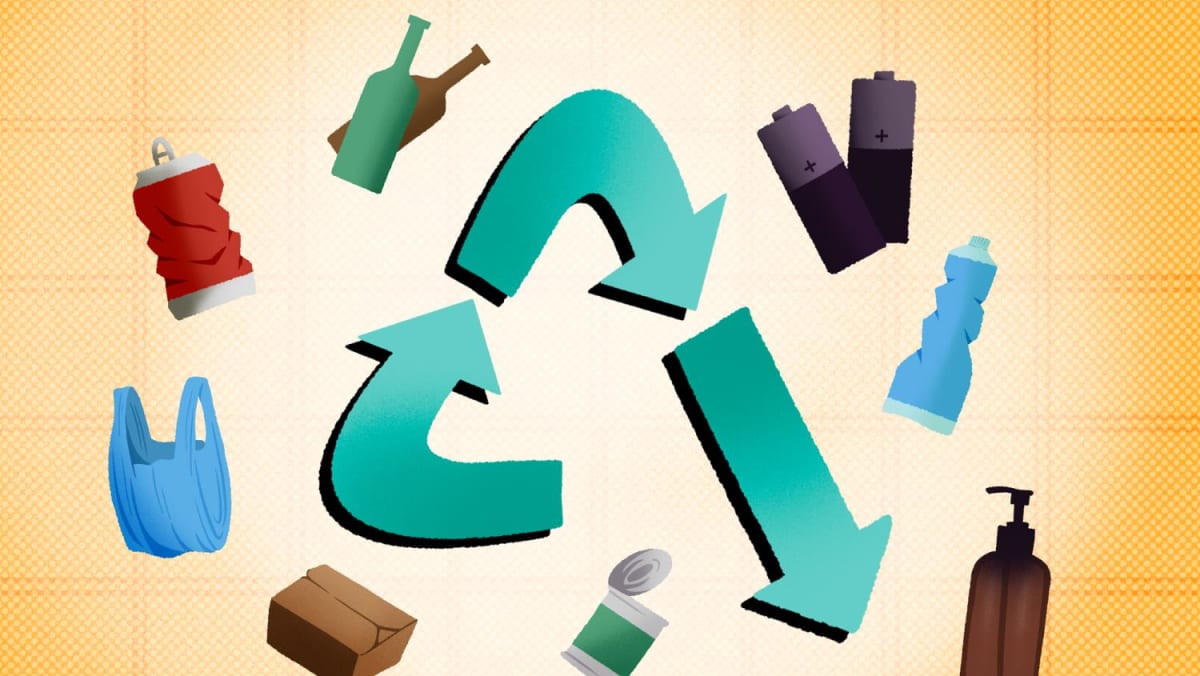
Each week, TODAY’s long-running Big Read series delves into the trends and issues that matter. This week, we look at Singapore’s falling domestic recycling rate and how it can be boosted. This is a shortened version of the full feature, which can be found here.
SINGAPORE — Property agent Rose Tan throws her domestic waste in the designated blue recycling bins below her flat two to three times a day.
“Things like metal cans can be remade into something else, and they’re very useful for us. Why waste it?” said the 75-year-old.
Other residents in several housing estates whom TODAY spoke to last week also said that they make it a point to dispose of their waste materials in the blue bins below their flats for recycling.
They represent a growing number of Singaporeans who are aware of the virtues of recycling, widely regarded as a key solution to the ever-growing mountain of rubbish around the world.
Still, despite such awareness, the recycling rate for domestic waste — from households and premises such as schools and hawker centres — in Singapore has fallen in the last five years.
According to NEA statistics, the domestic recycling rate stood at 12 per cent last year, the lowest level in over a decade, and down from 22 per cent in 2018 and 13 per cent in 2021.
In response to TODAY’s queries, NEA said that the amount of paper and cardboard recycled has been lower since 2018 due to weaker demand from export markets and high freight costs.
Currently, all of Singapore’s paper and textile recyclables are exported for recycling.
E-commerce and online shopping has also led to an increase in paper and cardboard being disposed of, further reducing the recycling rate for these materials, said an NEA spokesperson.
THE BIG PICTURE
The drop in domestic recycling rate here coincides with external factors affecting the export of recyclable waste.
China, once the world’s largest importer of recyclable waste, banned the import of certain recyclable materials in 2018, including mixed paper and mixed plastics.
The ban, which followed several other regulations in the preceding years, was an attempt to curb the increasing amount of contaminated material that was clogging up the country’s material processing facilities.
Besides China, other countries such as Indonesia and Malaysia have also tightened their requirements for recycling waste imports. This has affected recyclable waste exports globally.
In Singapore, the amount of recyclable waste exported between 2015 and 2019 had also dropped steadily.
According to publicly available data, in 2015, 1,889,000 tonnes of recyclable waste were exported. This amounted to 41 per cent of Singapore’s total waste recycled that year.
In 2019, 1,439,000 tonnes of recyclable waste were exported, corresponding to 34 per cent of Singapore’s total waste recycled that year.
NEA had previously said that this waste was exported to countries including Australia, China, India, Indonesia, Malaysia, South Korea and Thailand for processing and recycling.
There is no publicly available data for subsequent years.
TODAY has asked the NEA and Ministry of Sustainability and the Environment (MSE) for updated figures on the amount of recyclable waste, including domestic waste, exported.
Besides international regulations on exports, shipping costs have also gone up due to the pandemic.
According to the Freightos Baltic Index, a global index that tracks the prices of shipping containers for goods transported by sea, the shipping container rate stood at US$8,236 on May 13, 2022 and has since dropped to US$1,440 as of May 12 this year.
The pandemic has also impacted recycling at a more downstream level, said experts.
Ms Jen Teo, executive director of the Singapore Environment Council, said that one reason for the drop in domestic recycling rate could be due to “revenge-shopping”, “revenge-dining-out” and “revenge-travelling” which has led to “a phenomenal rise” in trash production.
“The correct sorting and disposal of recyclable materials may become more difficult as a result of the increased waste creation,” said Ms Teo.
The rise in e-commerce during the pandemic also saw the emergence of sophisticated packaging and filling to ensure the safety of products as they were transported.
The mix of biodegradable and non-biodegradable materials in these packaging also led to complexities in recycling them, said Ms Teo.
THE BOTTOMLINE
Another issue that plagues recycling in Singapore is the contamination of recyclable trash — 40 per cent of what goes into the blue bins cannot be recycled. The contamination rate has hovered at 40 per cent since 2018.
For domestic recycling, Singapore uses a single-stream recyclables collection system where every residential block is given a blue recycling bin for residents to use. All recyclable trash is then thrown into the bin and sorted centrally.
The authorities have justified this single-stream, or commingling approach, as one that helps to improve the recycling rate as it is more convenient for residents to recycle without having to sort their recyclables by material type.
Stickers are currently placed on the blue bins, indicating to residents what can and cannot be thrown inside. However, residents still throw in contaminating items, such as food and liquids, thus undermining the efforts of those who have recycled correctly.
“Recyclables that are contaminated by food or liquids cannot be recycled which makes them no different from general waste,” said Zero Waste SG, an non-governmental group advocating for zero-waste in Singapore. Despite being intended for recycling, these contaminated trash would be disposed of, incinerated and landfilled.